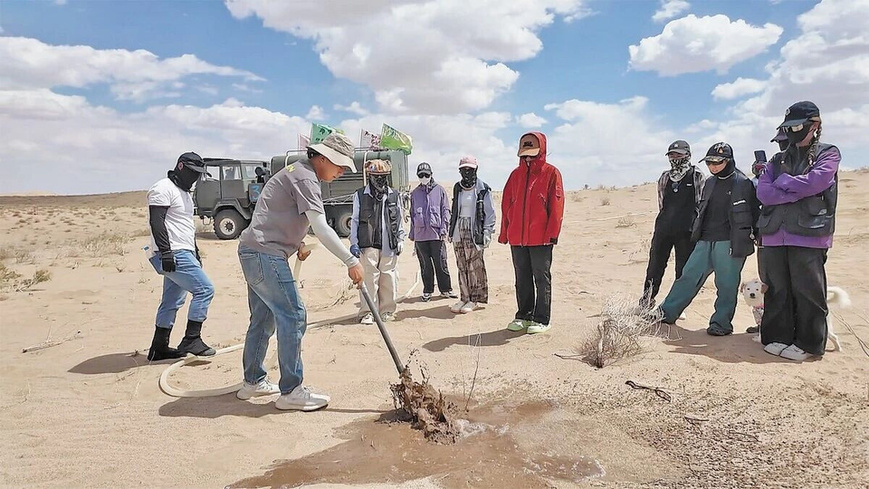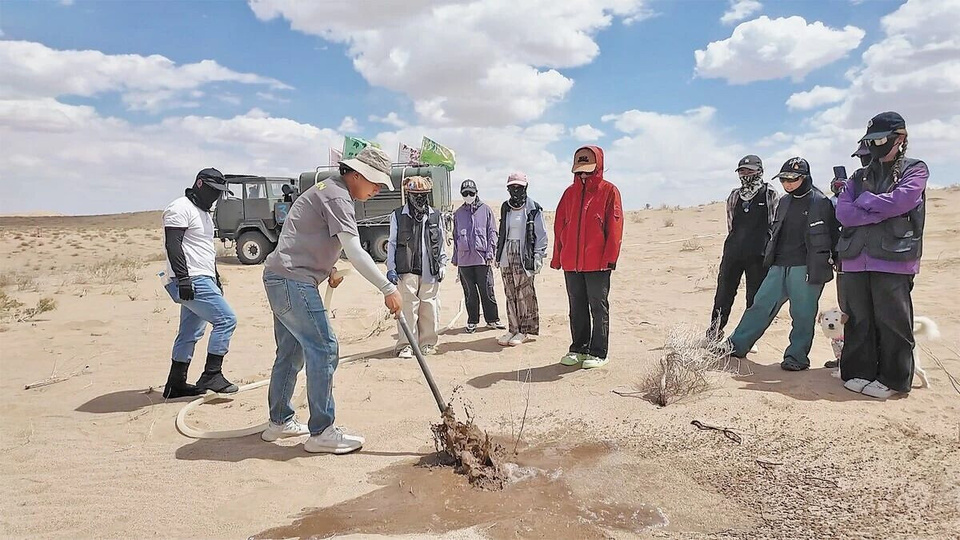By Zhao Shuaijie, People's Daily

Zhong Lin (second from left) instructs volunteers on seedling management. (People's Daily/Zhao Shuaijie)
In northwest China's Gansu province, Zhong Lin, a 27-year-old resident of Minqin county, has gained prominence for his extraordinary dedication to ecological restoration. He is often unreachable by phone or message, but can almost always be found working in the desert.
Zhong spends nearly two-thirds of a year living and working in the desert. He began his tree planting efforts as a college sophomore, funding his work through e-commerce and using short videos to raise public awareness and galvanize support.
Last year, he launched a volunteer campaign called "Come to Minqin and Plant a Tree," which has mobilized more than 41,000 participants to plant 1.52 million drought-resistant shrubs across 4,500 mu (about 300 hectares) of barren land.
Nestled between the Tengger and Badain Jaran deserts, Minqin has long struggled with desertification, which once affected more than 90 percent of its land. Zhong grew up in Fengzheng village on the county's northeastern edge, where he still vividly remembers springtime sandstorms that blotted out the sky.
For the residents of Minqin, protecting their homes, preserving the ecosystem, and ensuring agricultural productivity are all contingent upon the effective control of sand and desertification. Since the 1950s, successive generations have taken part in organized tree-planting campaigns.
Zhong was deeply impressed as a child by his elders carrying bundles of wheat straw, shouldering shovels, and hauling water carts into the desert to stabilize shifting dunes. Inspired by their perseverance, he launched his own desertification control efforts in 2020. But reality hit hard: most of the 500 shrubs he planted withered within weeks because of shallow pits and irregular watering.
Undaunted, Zhong persisted. In early 2022, with savings from his e-commerce ventures, he returned to the desert with renewed determination. This time, he devoted himself to studying scientific methodologies and consulting with experienced local planters. He established a temporary residence in the desert, where he meticulously recorded temperature fluctuations, wind speeds, and soil moisture levels while tending to each seedling. The systematic approach resulted in a survival rate of over 90 percent.
"Sweet and juicy melons from the desert - place your orders now!" Zhong often cheerfully promotes produce via livestream. Thanks to sandy soils, abundant sunlight, and significant diurnal temperature variation, Minqin provides an ideal environment for cultivating melons. "Marketing this produce can increase farmers' income while generating capital for our ongoing desert control efforts," Zhong explained.
He emphasized that passion must be complemented by scientific rigor. To address the specific challenges posed by the Tengger Desert's coarse and arid sand, Zhong and his team conducted numerous trials before setting on an optimal approach: digging pits 40 centimeters wide and deep, watering each seedling twice, and arranging plants in a north-south orientation with two-meter spacing to mitigate wind damage.
By 2023, his team had successfully rehabilitated more than 1,000 mu of desertified land, planting resilient shrubs such as saxaul, red willow, and camel thorn. Technology has also proved transformative. "One machine can excavate over 3,000 pits per day, increasing efficiency tenfold compared with manual labor. And drones let us track seedling survival rates with far greater accuracy than our eyes," Zhong said.
In early 2024, Zhong received a call from producers of an online reality show. For over two weeks, the production crew and accompanying volunteers joined him in the desert, engaging in pit-digging, planting, watering, and backfilling. Together, they planted 180,000 shrubs.
Following the program's broadcast, engagement on Zhong's social media platforms surged exponentially, with a single video topping nine million views. Rather than being swayed by this sudden prominence, he posed a critical question: how could this online attention turn into tangible action for desert control?
He promptly observed an influx of comments from individuals expressing a desire to participate. In response, he launched the "Come to Minqin and Plant a Tree" initiative, publishing detailed guides online and drafting a green pledge to encourage and facilitate participation.
"The initiative gained significant momentum this spring," Zhong said. Volunteers flocked to Minqin from across the country, including recent graduates, seasoned environmentalists, and retirees. Liu Beili, a university student, participated in spring planting and returned during the summer to water the saplings. Seventy-two-year-old Cheng Xiuqiong traveled more than 2,000 kilometers from Guangdong province in south China, switching between plane, train, and bus to contribute her strength. Over the months, more than 41,000 people have joined the campaign.
To accommodate the influx of volunteers, Zhong established a desert base that provides free lodging and meals while offering instruction on arboriculture techniques. Local authorities provided substantial support by supplying seedlings, installing a dedicated power line, building gravel roads, and partnering with hotels and restaurants to offer discounted services and over 15,000 free meals.
Today, Zhong and his team have pioneered a sustainable model where industrial development supports ecological preservation. "For every box of fruit sold, 70 percent of the profits are reinvested into our desert control efforts," Zhong explained. Looking out over the expanding stretches of greenery, he affirmed, "We'll stay committed to public-interest desert control, and we hope to inspire more young people to join the fight against desertification."
Zhong spends nearly two-thirds of a year living and working in the desert. He began his tree planting efforts as a college sophomore, funding his work through e-commerce and using short videos to raise public awareness and galvanize support.
Last year, he launched a volunteer campaign called "Come to Minqin and Plant a Tree," which has mobilized more than 41,000 participants to plant 1.52 million drought-resistant shrubs across 4,500 mu (about 300 hectares) of barren land.
Nestled between the Tengger and Badain Jaran deserts, Minqin has long struggled with desertification, which once affected more than 90 percent of its land. Zhong grew up in Fengzheng village on the county's northeastern edge, where he still vividly remembers springtime sandstorms that blotted out the sky.
For the residents of Minqin, protecting their homes, preserving the ecosystem, and ensuring agricultural productivity are all contingent upon the effective control of sand and desertification. Since the 1950s, successive generations have taken part in organized tree-planting campaigns.
Zhong was deeply impressed as a child by his elders carrying bundles of wheat straw, shouldering shovels, and hauling water carts into the desert to stabilize shifting dunes. Inspired by their perseverance, he launched his own desertification control efforts in 2020. But reality hit hard: most of the 500 shrubs he planted withered within weeks because of shallow pits and irregular watering.
Undaunted, Zhong persisted. In early 2022, with savings from his e-commerce ventures, he returned to the desert with renewed determination. This time, he devoted himself to studying scientific methodologies and consulting with experienced local planters. He established a temporary residence in the desert, where he meticulously recorded temperature fluctuations, wind speeds, and soil moisture levels while tending to each seedling. The systematic approach resulted in a survival rate of over 90 percent.
"Sweet and juicy melons from the desert - place your orders now!" Zhong often cheerfully promotes produce via livestream. Thanks to sandy soils, abundant sunlight, and significant diurnal temperature variation, Minqin provides an ideal environment for cultivating melons. "Marketing this produce can increase farmers' income while generating capital for our ongoing desert control efforts," Zhong explained.
He emphasized that passion must be complemented by scientific rigor. To address the specific challenges posed by the Tengger Desert's coarse and arid sand, Zhong and his team conducted numerous trials before setting on an optimal approach: digging pits 40 centimeters wide and deep, watering each seedling twice, and arranging plants in a north-south orientation with two-meter spacing to mitigate wind damage.
By 2023, his team had successfully rehabilitated more than 1,000 mu of desertified land, planting resilient shrubs such as saxaul, red willow, and camel thorn. Technology has also proved transformative. "One machine can excavate over 3,000 pits per day, increasing efficiency tenfold compared with manual labor. And drones let us track seedling survival rates with far greater accuracy than our eyes," Zhong said.
In early 2024, Zhong received a call from producers of an online reality show. For over two weeks, the production crew and accompanying volunteers joined him in the desert, engaging in pit-digging, planting, watering, and backfilling. Together, they planted 180,000 shrubs.
Following the program's broadcast, engagement on Zhong's social media platforms surged exponentially, with a single video topping nine million views. Rather than being swayed by this sudden prominence, he posed a critical question: how could this online attention turn into tangible action for desert control?
He promptly observed an influx of comments from individuals expressing a desire to participate. In response, he launched the "Come to Minqin and Plant a Tree" initiative, publishing detailed guides online and drafting a green pledge to encourage and facilitate participation.
"The initiative gained significant momentum this spring," Zhong said. Volunteers flocked to Minqin from across the country, including recent graduates, seasoned environmentalists, and retirees. Liu Beili, a university student, participated in spring planting and returned during the summer to water the saplings. Seventy-two-year-old Cheng Xiuqiong traveled more than 2,000 kilometers from Guangdong province in south China, switching between plane, train, and bus to contribute her strength. Over the months, more than 41,000 people have joined the campaign.
To accommodate the influx of volunteers, Zhong established a desert base that provides free lodging and meals while offering instruction on arboriculture techniques. Local authorities provided substantial support by supplying seedlings, installing a dedicated power line, building gravel roads, and partnering with hotels and restaurants to offer discounted services and over 15,000 free meals.
Today, Zhong and his team have pioneered a sustainable model where industrial development supports ecological preservation. "For every box of fruit sold, 70 percent of the profits are reinvested into our desert control efforts," Zhong explained. Looking out over the expanding stretches of greenery, he affirmed, "We'll stay committed to public-interest desert control, and we hope to inspire more young people to join the fight against desertification."
 Menu
Menu
 A young Chinese man inspires over 40,000 people to join desertification control
A young Chinese man inspires over 40,000 people to join desertification control
















